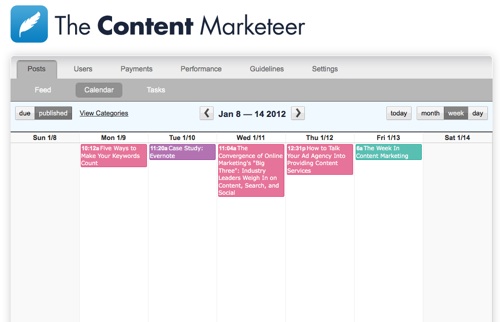A couple years ago, I was developing an editorial calendar for an agency blog, which had been around for a few years and was doing well. But the company was in the middle of re-branding, and the person who had been running the blog had too much on her plate to continue doing it alone.
Just a couple months ago, the editor and publisher of the Marketeer sat down to put together their publishing schedule for this site as well.
In both cases, the process of establishing an editorial calendar began with answering the questions I went over yesterday.
What would we publish?
Agency: Short entries about marketing and advertising in our target industries.
Marketeer: To start out, short and long posts and articles in various formats, as well as newsletters. Packages, white papers, video, and more time-intensive types of content down the road. All based on content marketing and the context surrounding it currently.
Who would contribute?
Agency: Members of the sales team (who we wanted to position as experts), department heads (who had extensive knowledge of their teams’ expertise), and employees who had a unique perspective or story idea and an interest in contributing.
Marketeer: Everyone on staff, as well as readers, are encouraged to contribute ideas for content, which is then created by a combination of freelance contributors, guest bloggers, and a couple staffers.
How often would we publish?
Agency: Two to three times per week.
Marketeer: One post or article every weekday; one newsletter each Friday; and special-release content (video, white papers, deeper reporting, etc.) selectively around notable occasions, such as conferences or real-time news events in the industry.
How would we run our process?
Agency: Simplicity was the goal. We had subject matter experts write the articles, which were then reviewed, edited, uploaded, and published by one editor. This editor was in charge of not only publishing, but process, scheduling, and maintenance of the original editorial calendar.
Marketeer: Simplicity is the aim here, as well, although with the help of various contributors and guest bloggers involved in pitching, writing, and revising copy, as well as sharing their contributions via social networks. The editor is in charge of making/approving assignments, editing them based on the Marketeer’s guidelines, and publishing, as well as optimizing and promoting this original content. She’s also responsible for making sure contributors are paid for their work.
What system would we use?
Agency: For scheduling the subject matter experts, we used a project management system already in place. The system allowed us to set aside two- or three-hour blocks of time for our contributors on a specific weekday, then schedule time for editing and upload later in the week.
Marketeer: Kapost, of course. Otherwise, after twelve years of editing various publications and types of content in print and online, the editor would have fallen back on her old system of email and loads of spreadsheets.
In both cases, once we had our systems running, it was up to the editor to keep them going, check in with contributors, watch for notifications when projects were late, and keep us in the loop if she needed a change in strategy.
The Takeaway
Start by defining your basic needs and capabilities, then pick the system that best fits them, and start your project. Don’t forget to reevaluate as you move along, shifting your editorial calendar to reflect what you can realistically accomplish—what you can genuinely promise to your users.

